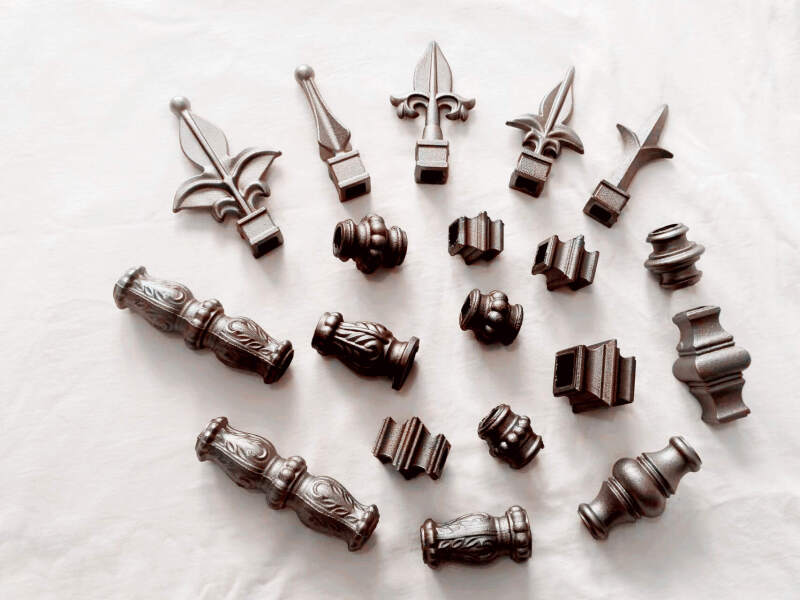
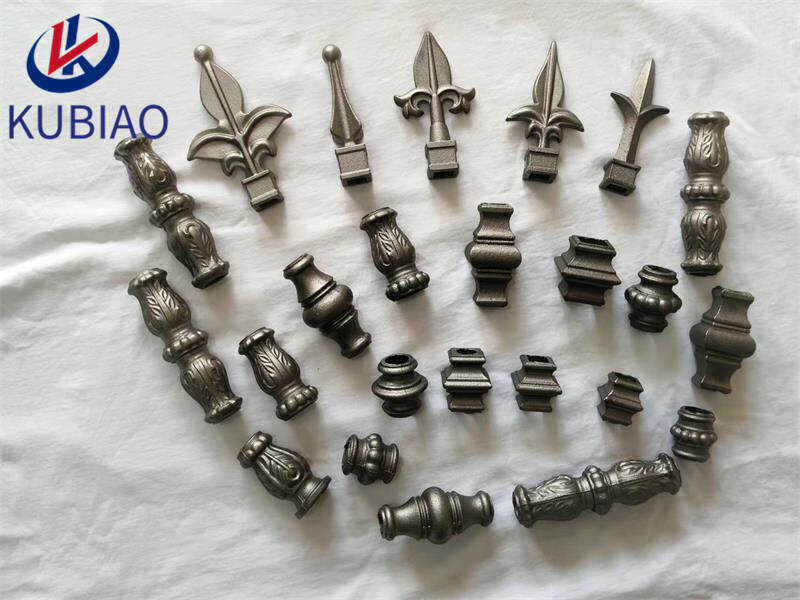
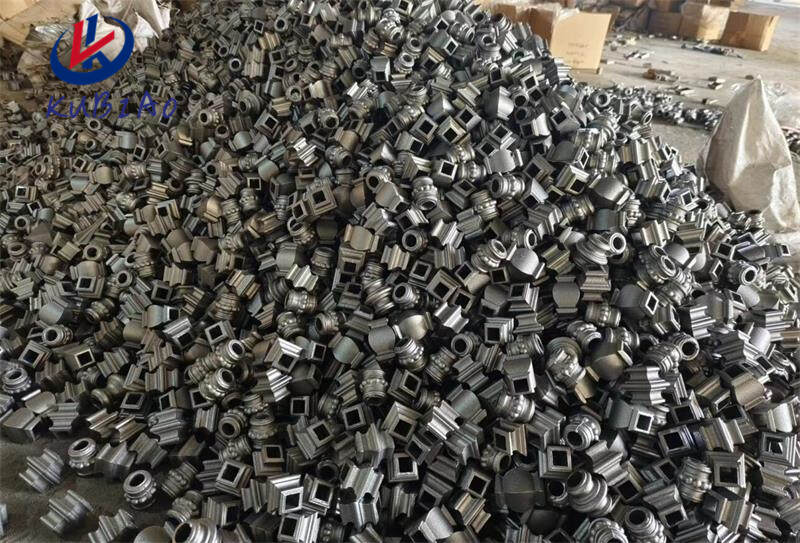
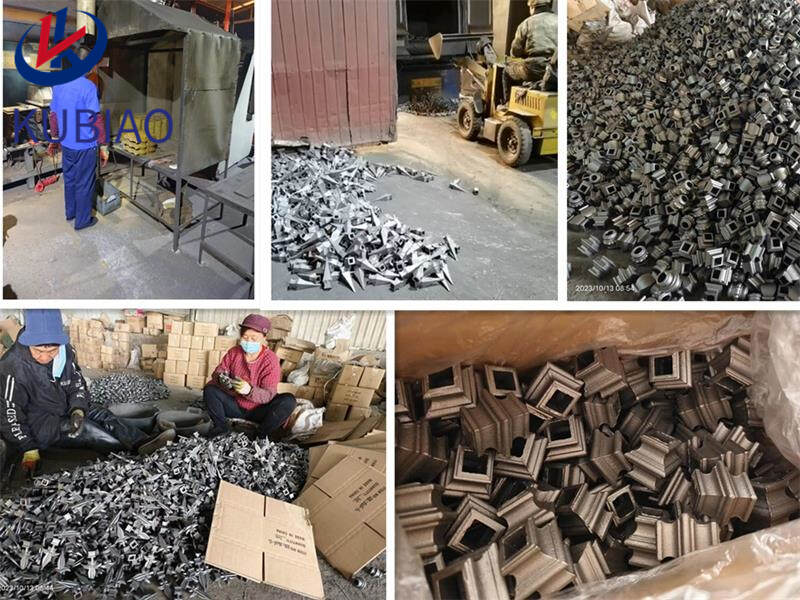
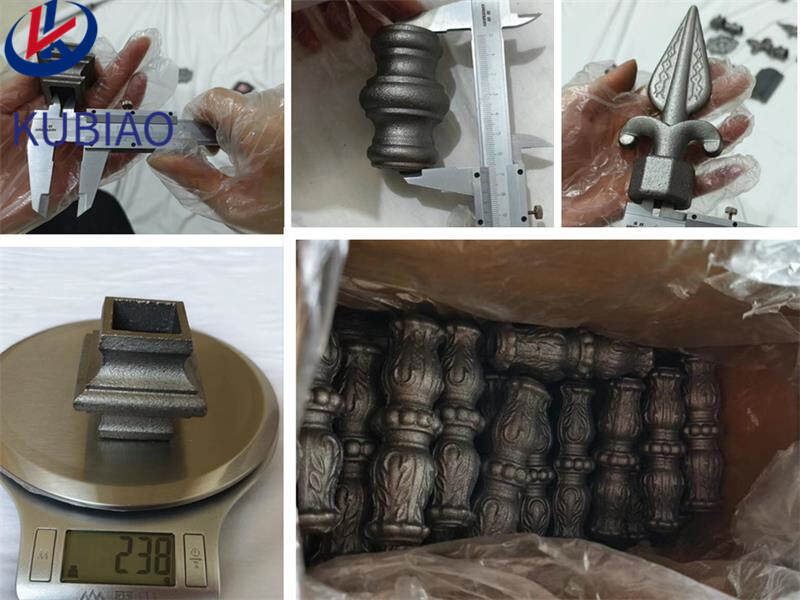
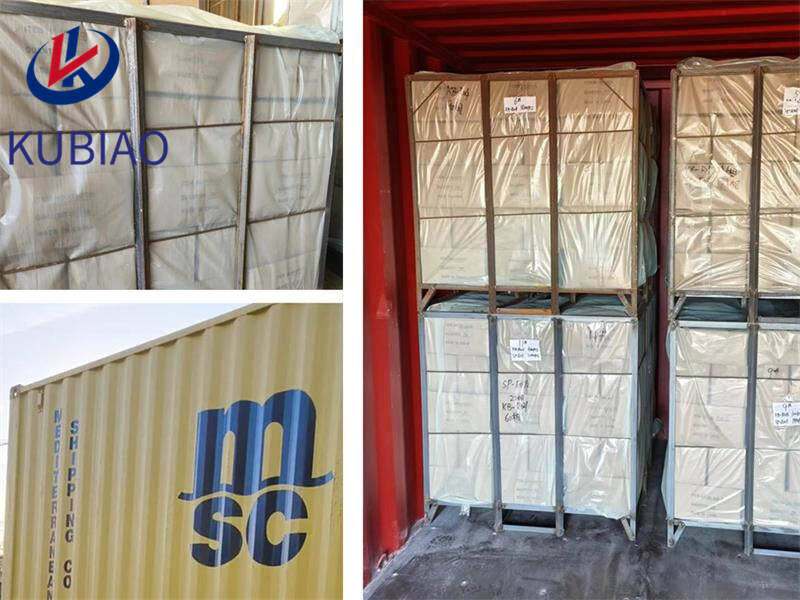
| Product name | gate ornaments |
| Keyword | iron cast spears ,ornamental iron,iron fence flower parts,iron leaf ornament,casting elements ,Cast Iron Caps,cast iron cap,ornamental iron gate decoration |
| Place of Origin | China |
| Quality standard | We have our own professional QC team to insure the quality. |
| Feature | Cast iron is a strong metal material that can withstand large amounts of pressure and weight. It is also durable and resistant to corrosion, making it ideal as a decorative item |
| Application scope | Tea room, etc. |
| surface treatment | sand blasting antirust antirust oil/water painting hot dip galvanizing |
| Unit Weight(g) | 353(Contact us for specific information to confirm) |
| terms of payment | 50% T/T in advance, balance before shipment. |
| Life span | 17 years (Contact us for specific information to confirm) |
| delivery time | It usually takes 40 days. |
| Advantage | We keep good quality and competitive price to ensure our customers benefit |
| Packing | 14x12.58x15.3cm(Contact us for specific information to confirm) |
| OEM/ODM | Customization Service Provided |
| design | beautiful elegance sleek pretty |
| Sales country | All over the world for example:Cambodia,Vanuatu,Chad,South Africa,Somalia,Central African Republic,Bhutan,Bahrain,Jan Mayen |
| MOQ | 277pcs(Contact us for specific information to confirm) |
1.What is the history of gate ornaments ?
We pay attention to the introduction and training of talents, scientifically regulate the management system, and focus on cultural construction and team cohesion.
Cast iron ornaments have a long and rich history dating back to ancient civilizations. The use of cast iron for decorative purposes can be traced back to the 5th century BC in China, where it was used to create intricate and ornate objects such as bells and statues.
In Europe, the use of cast iron for decorative purposes began in the 15th century, with the production of cast iron firebacks and grates for fireplaces. These were often adorned with intricate designs and patterns, and were considered a symbol of wealth and status.
During the Industrial Revolution in the 18th and 19th centuries, cast iron became more widely available and affordable, leading to an increase in its use for decorative purposes. Cast iron ornaments were used to decorate buildings, parks, and gardens, and were also popular as household items such as door knockers, garden furniture, and garden urns.
In the late 19th and early 20th centuries, the Victorian era saw a surge in the popularity of cast iron ornaments. The ornate and elaborate designs of the Victorian era were perfectly suited to the versatility of cast iron, and it was used extensively in the construction of buildings, bridges, and other structures.
However, with the advent of new materials such as steel and aluminum, the use of cast iron for decorative purposes declined in the 20th century. It was not until the lat<
br> 20th century that there was a renewed interest in cast iron ornaments, with a growing appreciation for their historical and aesthetic value.
Today, cast iron ornaments are still used to decorate buildings, parks, and gardens, and are also popular as collectibles and antiques. They are valued for their durability, intricate designs, and historical significance, and continue to be a popular choice for adding a touch of elegance and charm to any space.
2.Are gate ornaments more durable than other types of ornaments?
We should enjoy a good reputation in the industry, and we can increase the added value of the products of cooperative customers through technological innovation.
Yes, cast iron ornaments are generally more durable than other types of ornaments. This is because cast iron is a strong and sturdy material that is resistant to rust and corrosion. It can withstand harsh weather conditions and is less likely to break or chip compared to other materials such as plastic or ceramic. Additionally, cast iron ornaments are often heavier and more solid, making them less likely to be knocked over or damaged.
3.How have gate ornaments evolved over time?
We focus on innovation and continuous improvement to maintain a competitive advantage.
Cast iron ornaments have evolved significantly over time, both in terms of their design and production methods. Here are some key changes that have occurred:
1. Early designs: The earliest cast iron ornaments were simple and functional, such as door knockers, hinges, and fireplace tools. These were often made using sand casting techniques and had a utilitarian look.
2. Victorian era: In the mid-19th century, cast iron ornaments became more decorative and ornate, reflecting the Victorian love for intricate designs and embellishments. This era saw the rise of cast iron garden furniture, fountains, and statues, often featuring elaborate floral and animal motifs.
3. Industrial revolution: With the advent of the industrial revolution, cast iron ornaments became more affordable and accessible to the middle class. This led to a proliferation of cast iron products, including street lamps, railings, and building facades.
4. Art Nouveau and Art Deco: In the late 19th and early 20th centuries, cast iron ornaments were influenced by the Art Nouveau and Art Deco movements, which favored more fluid and geometric designs respectively. This led to the creation of cast iron gates, grilles, and other architectural elements with intricate patterns and motifs.
5. Modern era: In the 20th century, cast iron ornaments continued to evolve, with a focus on functionality and minimalism. Modern designs often feature clean lines and geometric shapes, and are used in a variety of applications, from furniture to home decor.
6. Production methods: While sand casting was the primary method of producing cast iron ornaments in the past, modern techniques such as die casting and investment casting have made the process more efficient and precise. This has allowed for the creation of more intricate and detailed designs.
7. Materials: While cast iron was the preferred material for ornaments in the past, modern advancements have led to the use of other materials such as aluminum and bronze. These materials offer greater strength and durability, while still retaining the look and feel of cast iron.
Overall, cast iron ornaments have evolved from simple and functional objects to highly decorative and versatile pieces, reflecting the changing tastes and advancements in technology over time.
4.What are gate ornaments ?
We have flexible production capacity. Whether you are large orders or small orders, you can produce and release goods in a timely manner to meet customer needs.
Cast iron ornaments are decorative objects made from cast iron, a type of iron that is heated until it becomes molten and then poured into a mold to create a specific shape. These ornaments can range from small figurines and sculptures to larger architectural elements such as columns, balusters, and finials. They are often used to add a touch of elegance and charm to gardens, homes, and other outdoor spaces. Cast iron ornaments are known for their durability and can withstand harsh weather conditions, making them a popular choice for outdoor decor. They can also be painted or finished in various colors and styles to suit different design preferences.
5.How do I protect gate ornaments from rust?
We pay attention to user experience and product quality, and provide the best product quality and lowest production cost for cooperative customers.
1. Clean and dry the ornaments: Before applying any protective coating, make sure the ornaments are clean and dry. Use a wire brush or sandpaper to remove any rust or dirt.
2. Apply a rust converter: Rust converters are chemical solutions that convert rust into a stable compound that can be painted over. Apply the converter according to the manufacturer's instructions and let it dry completely.
3. Use a rust-inhibiting primer: Once the rust converter has dried, apply a rust-inhibiting primer to the ornaments. This will create a barrier between the metal and the environment, preventing rust from forming.
4. Paint with a rust-resistant paint: After the primer has dried, paint the ornaments with a rust-resistant paint. This type of paint contains additives that prevent rust from forming.
5. Apply a clear coat: For added protection, you can apply a clear coat over the painted surface. This will provide an extra layer of protection against moisture and other elements.
6. Keep the ornaments dry: Moisture is the main cause of rust, so it's important to keep the ornaments dry. If they are placed outdoors, make sure they are covered or brought inside during rainy or humid weather.
7. Reapply protective coating regularly: Over time, the protective coating on the ornaments may wear off. It's important to reapply the rust converter, primer, and paint every few years to keep the ornaments protected.
8. Store indoors during winter: If possible, store the ornaments indoors during the winter months to protect them from harsh weather conditions.
9. Use a rust inhibitor: You can also use a rust inhibitor spray or gel to protect the ornaments. These products create a thin film over the metal, preventing rust from forming.
10. Regularly inspect and maintain: Regularly inspect the ornaments for any signs of rust and touch up any areas that may need it. This will help prevent rust from spreading and keep your ornaments looking like new.
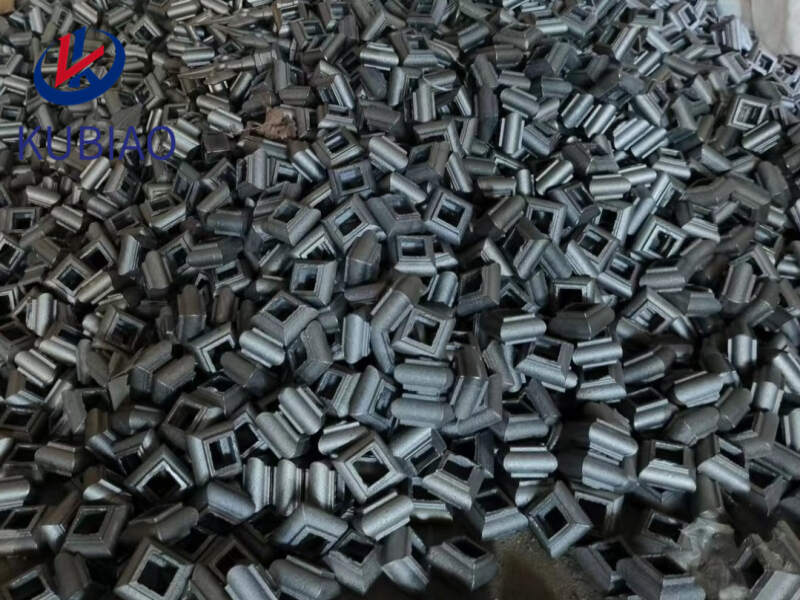
6.Are there any eco-friendly options for gate ornaments ?
We are committed to providing personalized solutions and established long -term strategic cooperative relationships with customers.
Yes, there are several eco-friendly options for cast iron ornaments:
1. Recycled Cast Iron: Look for cast iron ornaments that are made from recycled materials. This reduces the need for new resources and helps to minimize waste.
2. Sustainable Production: Some companies use sustainable production methods, such as using renewable energy sources and minimizing water usage, to create their cast iron ornaments.
3. Organic Coatings: Instead of traditional paint or varnish, some cast iron ornaments are coated with organic materials, such as linseed oil or beeswax, which are more environmentally friendly.
4. Fair Trade: Look for cast iron ornaments that are certified as fair trade, meaning they are produced in an ethical and sustainable manner, and workers are paid fair wages.
5. Vintage or Secondhand: Consider purchasing vintage or secondhand cast iron ornaments instead of new ones. This reduces the demand for new production and gives new life to old items.
6. DIY: If you have some basic metalworking skills, you can create your own cast iron ornaments using recycled materials or scrap metal.
7. Upcycled: Some companies specialize in upcycling old cast iron items, such as old radiators or pipes, into unique and eco-friendly ornaments.
8. Biodegradable Packaging: When purchasing cast iron ornaments, look for companies that use biodegradable or recyclable packaging materials to reduce waste.
9. Local Production: Choosing cast iron ornaments that are locally produced reduces the carbon footprint associated with transportation and supports your local economy.
10. Longevity: Cast iron ornaments are known for their durability and longevity. By choosing high-quality, long-lasting ornaments, you can reduce the need for frequent replacements and ultimately reduce waste.
7.How can I incorporate gate ornaments into my holiday decor?
We are a new gate ornaments manufacturer.
1. Hang them on the Christmas tree: Use small cast iron ornaments as unique and rustic additions to your Christmas tree. They can add a touch of vintage charm and contrast well with traditional glass or plastic ornaments.
2. Create a centerpiece: Arrange a few cast iron ornaments in a bowl or on a tray with some greenery and candles to create a festive centerpiece for your dining table or mantel.
3. Use as stocking holders: Instead of traditional stocking holders, use heavy cast iron ornaments to hold up your stockings. They will add a unique and unexpected touch to your holiday mantel.
4. Decorate your wreath: Add some interest to your holiday wreath by incorporating a few cast iron ornaments into the design. They can be hung from the wreath or nestled among the greenery.
5. Place on a garland: String a garland along your staircase or mantel and use cast iron ornaments as accents throughout. This will add a rustic and charming touch to your holiday decor.
6. Use as napkin rings: Wrap a small cast iron ornament around a cloth napkin to create a unique and festive napkin ring for your holiday table setting.
7. Hang on doorknobs: Add a touch of holiday cheer to your doors by hanging cast iron ornaments on the doorknobs. This is a simple and easy way to incorporate them into your decor.
8. Create a vignette: Arrange a few cast iron ornaments on a tray or in a bowl with other holiday decorations, such as pinecones, candles, or greenery, to create a festive vignette for your coffee table or sideboard.
9. Personalize with paint: If you have plain cast iron ornaments, you can personalize them by painting them with holiday designs or messages. This is a fun and creative way to make them stand out in your decor.
10. Use as gift toppers: Instead of traditional bows or ribbons, use small cast iron ornaments as gift toppers. This will add a unique and rustic touch to your gift wrapping.
8.Can I use gate ornaments as part of a fireplace mantel display?
We continue to invest in research and development and continue to launch innovative products.
Yes, you can use cast iron ornaments as part of a fireplace mantel display. Cast iron ornaments can add a rustic and vintage touch to your mantel display and can be used to hold candles, vases, or other decorative items. Just make sure to properly secure them to the mantel to prevent any accidents.
9.How are gate ornaments made?
We continue to improve gate ornaments products and processes to improve efficiency.
1. Creating a Design: The first step in making cast iron ornaments is to create a design. This can be done by hand-drawing or using computer-aided design (CAD) software.
2. Making a Mold: Once the design is finalized, a mold is created. This can be made from wood, metal, or other materials. The mold is usually made in two halves, with the design carved or etched into it.
3. Preparing the Iron: Cast iron is made by melting iron and adding other elements such as carbon, silicon, and manganese to create a strong and durable material. The iron is heated in a furnace until it reaches a molten state.
4. Pouring the Iron: Once the iron is molten, it is poured into the mold. The mold is usually preheated to prevent the iron from cooling too quickly and to ensure a smooth finish.
5. Cooling and Removal: The iron is left to cool and solidify in the mold. Once it has cooled, the mold is opened and the cast iron ornament is removed.
6. Finishing: The cast iron ornament may have rough edges or imperfections from the casting process. These are removed by grinding, sanding, or filing. The ornament may also be polished or painted to achieve the desired finish.
7. Inspection: The finished ornament is inspected for any defects or imperfections. Any necessary touch-ups or repairs are made at this stage.
8. Packaging and Shipping: The final step is to package the cast iron ornament for shipping or display. This may involve adding protective packaging or attaching hanging hardware if necessary.
10.What are some popular uses for gate ornaments ?
We should perform well in market competition, and the prices of gate ornaments products have a great competitive advantage.
1. Garden Decorations: Cast iron ornaments are commonly used as garden decorations, such as planters, statues, and bird baths.
2. Home Decor: Cast iron ornaments can add a touch of elegance and charm to any room in the house. They can be used as wall hangings, bookends, or as decorative accents on shelves and tables.
3. Architectural Details: Cast iron ornaments are often used as architectural details on buildings, such as door knockers, window grills, and balcony railings.
4. Fireplace Accessories: Cast iron ornaments can be used as fireplace accessories, such as firebacks, grates, and tool sets.
5. Furniture Accents: Cast iron ornaments can be incorporated into furniture design, such as table legs, chair backs, and drawer pulls.
6. Signage: Cast iron ornaments can be used as decorative elements on signs, both indoors and outdoors.
7. Holiday Decorations: Cast iron ornaments are popular for holiday decorations, such as Christmas tree ornaments and Halloween decorations.
8. Souvenirs and Gifts: Cast iron ornaments make unique and memorable souvenirs and gifts, as they can be personalized and have a timeless appeal.
9. Collectibles: Cast iron ornaments are often collected by enthusiasts for their historical and artistic value.
10. DIY Projects: Cast iron ornaments can be used in various DIY projects, such as creating custom wall art, jewelry, and home accents.
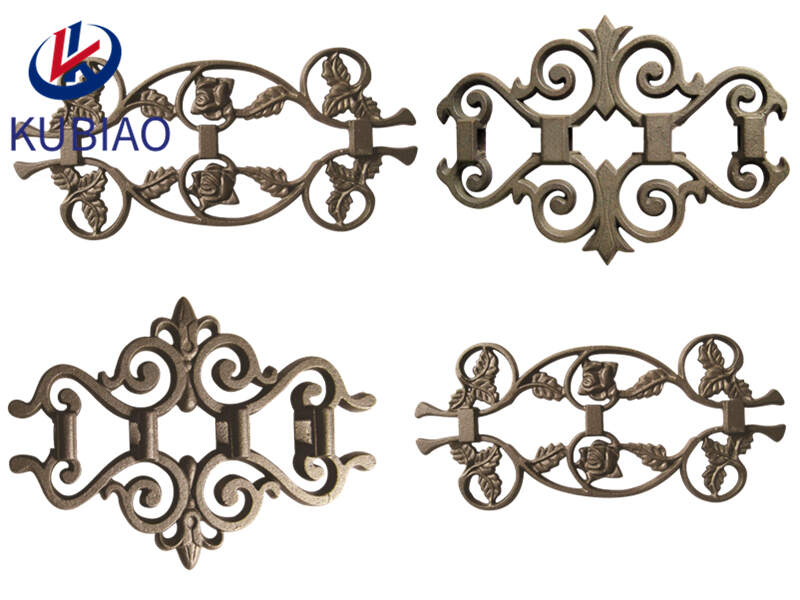
11.Are gate ornaments weather-resistant?
We maintain a stable growth through reasonable capital operations, focus on industry development trends and cutting -edge technologies, and focus on product quality and safety performance.
Yes, cast iron ornaments are weather-resistant. They are made from a durable and strong material that can withstand various weather conditions, including rain, snow, and extreme temperatures. However, over time, they may develop rust if not properly maintained. It is recommended to regularly clean and seal cast iron ornaments to ensure their longevity and weather-resistance.
12.Why are gate ornaments commonly used in outdoor settings?
We adhere to the principle of integrity and transparency, and establish long -term relationships with partners, and we attach great importance to this detail.
1. Durability: Cast iron is a strong and durable material that can withstand harsh outdoor conditions such as rain, wind, and sunlight. It is resistant to rust and corrosion, making it a long-lasting choice for outdoor use.
2. Weather-resistant: Cast iron is able to withstand extreme temperatures without cracking or warping, making it suitable for use in both hot and cold climates.
3. Weight: Cast iron is a heavy material, which makes it less likely to be blown over by strong winds or knocked over by animals or people. This makes it a safe and stable choice for outdoor settings.
4. Decorative: Cast iron ornaments come in a variety of intricate and decorative designs, making them a popular choice for adding visual interest and charm to outdoor spaces.
5. Low maintenance: Cast iron ornaments require minimal maintenance, making them a convenient choice for outdoor settings. They can be easily cleaned with soap and water and do not need to be repainted or refinished regularly.
6. Versatility: Cast iron ornaments can be used in a variety of outdoor settings, from gardens and patios to parks and public spaces. They can also be used for a range of purposes, such as garden edging, planters, and decorative accents.
7. Historical significance: Cast iron has been used for outdoor ornaments for centuries, giving it a sense of tradition and history. This adds to its appeal and makes it a popular choice for traditional and historic outdoor spaces.
13.How can I clean and maintain gate ornaments ?
We have established a good reputation and reliable partnerships within the gate ornaments industry.
1. Remove any dirt or debris: Use a soft-bristled brush or cloth to remove any dirt or debris from the surface of the cast iron ornament.
2. Wash with mild soap and water: Mix a small amount of mild soap with warm water and use a cloth or brush to gently scrub the ornament. Rinse with clean water and dry thoroughly with a towel.
3. Remove rust: If there is any rust on the ornament, use a wire brush or sandpaper to gently scrub it off. You can also use a commercial rust remover if the rust is stubborn.
4. Apply a protective coating: To prevent future rusting, apply a thin layer of oil or a specialized cast iron sealer to the ornament. Be sure to follow the manufacturer's instructions for application.
5. Store in a dry place: Moisture can cause cast iron to rust, so it is important to store your ornaments in a dry place when not in use.
6. Avoid harsh chemicals: Avoid using harsh chemicals or abrasive cleaners on your cast iron ornaments as they can damage the surface.
7. Regularly inspect and touch up: Inspect your ornaments regularly for any signs of rust or damage. If you notice any, clean and touch up the affected area immediately to prevent further damage.
8. Protect from extreme temperatures: Extreme temperatures can cause cast iron to expand and contract, leading to cracks or damage. Avoid exposing your ornaments to extreme heat or cold.
9. Handle with care: Cast iron ornaments can be heavy and fragile, so handle them with care when moving or storing them.
10. Seek professional help if needed: If your cast iron ornament is heavily rusted or damaged, it may be best to seek professional help for restoration.
Welcome to contact us for Cast Iron Order!
Email: sales@kubiaometal.com
Cellphone/Whatsapp: 0086 13020588163
Wechat: 13028588163
Tag:iron garden ornament ,casting collar,iron cast spears ,ornamental iron,cast iron elements
PREV: iron art decor
NEXT: gate finials cast iron
Product
Category